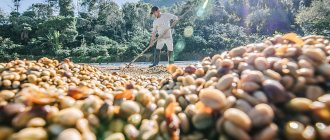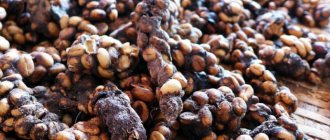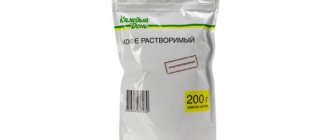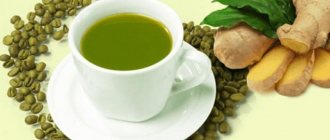Category: Organic fertilizers Reading time: 8 min · Views: 43,929
Everything will come in handy around the house, even coffee leftovers and tea leaves. This is the best natural fertilizer for home and garden plants. Coffee cake has recently been used as a fertilizer, and not everyone knows about it. Coffee waste contains microelements necessary for garden crops, and the composition of the soil will become loose and enriched. The pH index of the fertilizer is neutral, so it is acceptable for any type of soil. Let's look at all the ways to fertilize with coffee.
Cake composition
For people, the coffee drink is not of great value, but for plants it is a concentration of beneficial microelements. Potassium, phosphorus, nitrogen, copper - these important substances strengthen plant health and provide nutrition.
There is as much nitrogen in the cake as in rotted weeds. This is a very high figure, because crops need nitrogen for active vegetation.
Phosphorus, the content of which in coffee is quite sufficient for the development of crops, improves flowering and fruit set. Phosphorus is also indispensable during the formation of roots and improves the taste of fruits.
In addition to the listed elements vital for crops, coffee powder also contains other important minerals and trace elements.
Benefits of the cake:
- enrichment of the fertile layer with microelements;
- protection from certain types of pests;
- improving soil texture inexpensively;
- attracting soil microorganisms and earthworms;
- savings on the purchase of agrochemicals.
Some gardeners believe that with regular use of coffee fertilizer, agrochemicals are not needed at all. However, it is necessary to take into account the structure of the soil and its characteristics, because certain garden crops require a certain acidity of the fertile layer.
Can raw ground coffee powder be used as fertilizer? No, it is the coffee that is needed to feed the plants, otherwise it can harm the plants instead of benefiting them. The dried powder contains no acid, which is harmful to many crops.
As practice shows, not all seedlings like the coffee aroma. Gardeners have noticed that in areas where alfalfa and clover grow, it is better not to add grounds. Geraniums, cacti and succulents do not like coffee fertilizer.
Benefits of coffee cake for soil and plants
Dried coffee has a multifaceted beneficial effect on the soil and its inhabitants:
- enriches the soil with slowly soluble nitrogen;
- introduces earthworms to the beds;
- facilitates the absorption of copper, magnesium, phosphorus and potassium by plants;
- stimulates the proliferation of beneficial bacteria and fungi;
- improves soil air and water permeability;
- repels harmful insects;
- suppresses the development of pathogens of certain fungal diseases.
Blank
To ensure that you have enough fertilizer by spring, the powder must be collected in late autumn. This is very simple to do: you need to dry portions of the cake on parchment sheets. When the moisture has completely evaporated, you need to pour the dry substrate into a tin/glass container. They need to be stored in a darkened room.
Instant coffee is not suitable for feeding, only ground coffee.
You cannot fertilize with cake after a sweet drink. It is also unacceptable to dry the cake after coffee with milk or other additives. For feeding, only powder from ground grains cooked without any additives is used.
How to use grounds in the garden?
It can be mixed with plant seeds (carrots, beets), this will speed up germination. A mixture of soil and dry coffee substrate is placed in planting pots for seedlings; this soil mixture gives excellent results. The seedlings grow strong and can easily be transplanted into holes.
You can also scatter the substance around the rooted seedling, which will facilitate an increase in nitrogenous substances in the fertile soil layer after each watering.
Note! If you set fire to a handful of cake in the house, all the flies and mosquitoes will fly away.
Fertilizer can be buried to a depth of about 4 mm. This method will retain moisture after watering and provide an influx of oxygen into the soil.
When planting, use compost with grounds mixed with the fertile layer in half. This will provide the seedlings with the necessary nutrition.
Also, dry grounds are simply diluted with water and irrigated green spaces.
Improving the mechanical properties of soil
Spent coffee is used as a fertilizer in the country to improve the mechanical characteristics of the soil. The soil texture is improved by the biological elements of the grounds. It is especially useful to use cake on soils of heavy texture - clayey, loamy. On sandstones, coffee cake reduces acidity, which has a beneficial effect on the composition of the fertile layer.
Note! Coffee protects the garden from weeds.
However, if you regularly use cake for mulching, the soil layer can become compacted and begin to impede air permeability. Therefore, mix the substrate with fertilizers of a larger fraction.
Coffee as a fertilizer for plants
Dried coffee is an almost free way to provide plants with mineral nutrition. It is almost impossible to harm plants with this fertilizer, even with an overdose. For many garden, garden and indoor flowers. Ground coffee is especially effective as a fertilizer for flowers: roses, azaleas, ferns, begonias.
When used in the garden, dormant coffee is useful for feeding vegetables: peppers, tomatoes, carrots, radishes, as well as beans and peas. Fertilizer from coffee grounds can be used to feed herbs, lilies, garden roses, and ornamental shrubs. Spent grounds are actively used to feed berry and fruit bushes and trees. This helps increase crop yields.
Some gardeners believe that coffee residue increases acidity and is therefore not suitable for many plants. But that's not true. Coffee beans are highly acidic. But during the brewing process, almost all acids are washed out. The remaining coffee waste is neutral in acidity.
Making compost
Due to the high percentage of nitrogen, coffee waste is added to the compost. Such a substrate not only saturates the soil with nutrients, but also prevents fungal infections in seedlings.
To make a coffee compost pile, you need to prepare the area. Fence 1 m2 of land and put up borders. The pile should not exceed a meter in height.
Composition No. 1:
dry coffee grounds;
- wilted weeds;
- tree foliage;
- stale straw;
- 400-450 grams of bone meal.
Composition No. 2:
- liter of dried grounds;
- a mug of dry chicken;
- a couple of mugs of ash;
- a bucket of stale hay.
The ingredients are mixed well and sprinkled with earth on top. After this, the pile is irrigated with settled water and covered with film. To ensure good ventilation, the pile is periodically pierced in several places with a wooden stick. Make sure the compost does not dry out. In extreme heat, it is necessary to irrigate the pile as needed and poke it with a stick. After 3-4 weeks, the temperature in the heap will drop, at which time earthworms are added to it.
To save the pile until spring, you need to cover the compost well with tree branches or spruce branches. The pile is covered with leaves and insulated as thoroughly as possible.
To treat plants with compost, it is first diluted with water, and then the beds or bushes are irrigated at the root. You can also irrigate homemade flowers with liquid compost.
Compost for home flowers
To prepare a nutrient substrate for flowerpots, place dry coffee powder, dry tree leaves and crushed straw in a ratio of 50:30:20 in a bucket or other suitable container. The ingredients are mixed and soil is poured on top. The compost must be well established, so its moisture content should be controlled and moistened in time. To provide oxygen, the compost is pierced with a stick. In a month, the mixture will be completely ripe and can be used to feed flower crops.
Compost with coffee grounds
When you accumulate leftovers from an invigorating drink, use them to compost. When placed in compost, dormant coffee beans begin to function as nitrogen elements. They are the ones who start the combustion process and maintain the temperature inside the compost heap that helps plant debris to decompose better.
Sometimes gardeners specifically purchase grounds from nearby coffee shops, then spread the layers in compost. The aromatic collection is mixed with soil, leaves, straw, then sprinkled with plant debris in the compost heap. For greater benefit, you can send vermicompost there. Such compost will be the best organic fertilizer for garden plantings.
Cake for the garden
The role of coffee grounds as fertilizer in aerating the fertile layer and protecting against slugs is irreplaceable. The powder composition attracts earthworms, but is undesirable for slugs and snails. Also, red ants and rabbits do not like coffee: they leave the area.
To repel ants from the area, you need to sprinkle dry powder on the paths or sprinkle coffee substrate on the anthill. To repel aphids and slugs, plants are sprayed with a liquid solution.
If you need to protect your garden beds from cats, sprinkle them with a mixture of coffee grounds and orange zest.
Tomato seedlings respond well to coffee fertilizer. For tomatoes, the cake is used throughout the growing season. Thanks to the attraction of beneficial soil microorganisms and the formation of bacterial strains, the fertile layer is enriched with essential nutrients.
For berry bushes, cake is used as follows. You need to scatter 2-3 cups of dry substrate around the roots and water them with water. And when planting a young seedling, place three to four cups of dry fertilizer in the hole and water it. The cake is pre-mixed with the soil.
Note! An important property of dormant coffee is the delay in the accumulation of nitrates in vegetable fruits.
Mulching with thickets protects garden flowers and fruit trees from slugs and other parasites without the use of chemicals. Caffeine acts as a poison on pests and destroys their population. Also, the smell of coffee repels insects and other unwanted “guests” in the garden. However, it is recommended to mix the cake with soil so that it does not form a dense film around the trunk, preventing air permeability.
Coffee as fertilizer and protection for indoor plants and more
Coffee grounds are not only a useful fertilizer that enriches plants with minerals, but also protects them from a wide variety of pests.
The smell of coffee grounds is good at repelling the following insects:
- slugs;
- carrot fly;
- fruit flies;
- ants;
- other insect larvae.
By adding coffee when sowing radishes and carrots, you can repel insects and larvae living underground. The carrot fly disappears on carrots. Slugs and ants stay away from beds that are sprinkled with sleeping coffee, they are afraid of its pungent smell. Dormant coffee is effective against pests whenever applied to the soil.
Coffee grounds also attract beneficial insects. In such soil, many earthworms appear, which loosen the soil well. Worms also contribute to the rapid ripening of compost.
Cake for garden and home flowers
Spent coffee is placed at the bottom of the flowerpot as fertilizer for indoor flowers. It acts as drainage, retaining moisture and protecting the roots of flowers from excess moisture. For irrigation, use a solution: a teaspoon of powder per liter of fresh, settled water.
Coffee waste is also used in dry form. To do this, a substrate is scattered around the flower and watered with settled water. The earth must be loosened, otherwise the coffee powder will create an impenetrable film on the surface of the earthen clod. For flowers that love acidic soil, drink unslept coffee.
How many spoons of grounds should be placed in a flowerpot? It depends on the volume of the container - from one tsp to two tablespoons.
Do not put wet grounds in flower pots, as they encourage mold.
Bulbous flowers respond well to coffee fertilizer, as they extract enough nitrogen from it for rapid development. Daffodils, hyacinths and tulips will bloom much faster if you regularly treat them with grounds.
Rhododendrons often suffer from root weevil attacks. Spraying the bushes with coffee solution will prevent the appearance of unwanted guests.
Note! Many insects do not like the smell of coffee.
Roses, lilies and begonias are very fond of coffee fertilizing. Rose bushes are sprayed with diluted grounds to protect against midges and other insects. This is a universal remedy for the rosary.
How to feed a flower bed with coffee fertilizer? When forming a flowerbed, you need to make a special mixture: mix a glass of dry powder with a bucket of fertile soil and distribute it over the flowerbed. If the flowerbed is large, take the appropriate number of buckets of fertilizer.
Dry powder is also used to feed the bushes; it is poured around the flower and sprinkled with earth. When water enters during irrigation, nutrients penetrate the soil.
Bottom line
Coffee cake as a fertilizer is widely used in gardening and floriculture. Dry powder structures the soil and creates conditions for breathability. Fertilizer is either placed on the surface of the fertile layer under the plant, or made into a solution for irrigation, or incorporated into the soil. It feeds plants well and compost based on grounds, it is mixed with soil or watered under the roots with a solution.
Thanks to fertilizing, seedlings develop much faster, produce lush flowering and high-quality ovaries. After coffee fertilizing, the fruits acquire a bright taste and color. Some gardeners are confident that regular fertilization of plants with grounds completely replaces chemical fertilizers. However, it is not recommended to use raw powder; it is first dried and the lumps are crushed.
In addition to improving the growth of seedlings, coffee is also used to repel pests - beetles and insects, slugs and ants. The use of cake as a mulching material brings positive results. Organic additive in the form of dried coffee is universal for gardening.
Effect of coffee residues on plants
Unlike other similar fertilizers, nitrogen taken from coffee is not absorbed as quickly by crops. For example, fertilizing tomatoes takes a certain time. The chemical element becomes active only after the decomposition of microorganisms and bacteria in the soil.
Those who hope for a positive result with natural fertilization of crops should remember that its slow activation can play a negative role, because gardeners think not only about nitrogen, but also about phosphorus and potassium. Squeeze is rich in these elements in approximate proportions:
Coffee contains magnesium and copper, and calcium, zinc, manganese and iron become available after decomposition.
Many people believe that using coffee grounds in the garden leads to increased soil acidity, but almost all chemical compounds dissolve during brewing. Subsequently, a neutral acid-base balance is created, and the soil becomes a favorable environment for vegetables.










